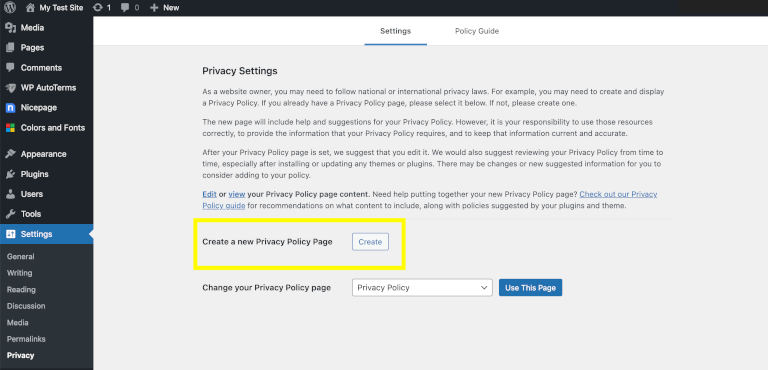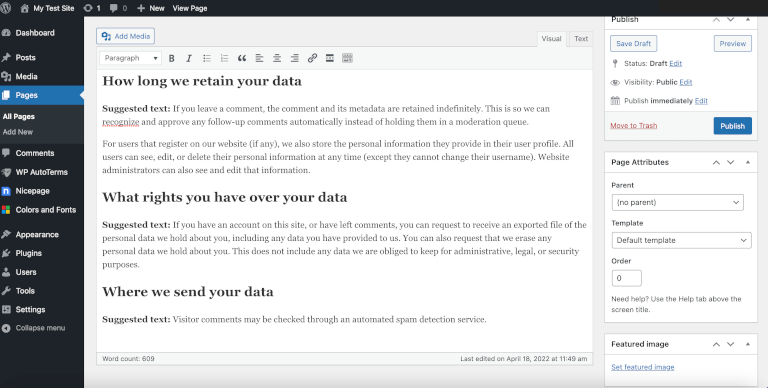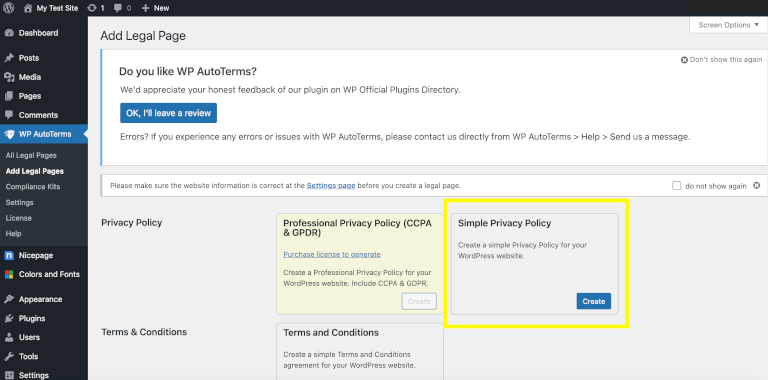Whether you run a blog, business website, or anything in between, people who visit your WordPress site have the legal right to know how you use their information. Privacy policies are essential documents that tell users how you collect and use their data. However, you might not know how to write and display a disclosure.
That’s why we’ve created a step-by-step guide to help you create a privacy policy that will both build trust with your site visitors and protect you from any potential legal issues. WordPress has a standard template you can fill out and publish on your page. Furthermore, some plugins can also help you out.
This guide will discuss what a privacy policy is and why it’s essential. Then, we’ll take you through writing your own disclosure and show you how to add it to your WordPress site.

An Overview of Privacy Policies
Many websites collect data from their audiences. This information can serve marketing purposes such as targeted ads. In general, many WordPress sites collect information about:
- Age, sex, and location
- Email addresses and phone numbers
- Any user behavior data gathered through tracking tools such as Google Analytics
- Comments
- Contact information from entry forms
- Data collected from security tools and plugins
A privacy policy is a document that explains to users how their data is used. Most websites have one in their footer or navigation menu:

In 2019, the Pew Research Center found that around 79 percent of Americans believe that companies won’t take responsibility if they misuse personal information. Furthermore, 62 percent of people think that both companies and the government collect personal data about them daily.
With privacy becoming an increasing concern, having a disclosure that explains how you use visitor information can help you build a trustworthy site.
Rules and regulations about privacy policies can differ by country. However, in general, if your site collects personal information about your visitors, you need to have a disclosure.
Why It’s Important to Have a Privacy Policy
A privacy policy is required by law for businesses, freelancers, and bloggers. Anyone who collects information from WordPress site visitors needs to have one.
For example, you need a privacy policy page to comply with the General Data Protection Regulation (GDPR). This is a European Union (EU) law that protects the data and privacy of internet users within the EU economic area:

Although other laws in countries outside the EU defend privacy, the GDPR is the strictest. There are financial penalties if you don’t comply with GDPR – up to a €20 million fine. You could even get prison time in the most severe cases.
Even if you’re not located in the EU, the regulations can still apply to you. For instance, if you offer products and services to EU residents or track their data, your website technically needs to comply with the GDPR.
Finally, as we already discussed, having a privacy policy is simply best practice for building user trust. Therefore, not having one on your WordPress website could seriously hurt your reputation and drive away readers.
What to Include in Your Site’s Privacy Policy
There are many different ways that your site might collect user data, and you’ll want to be transparent about each aspect. However, before we get into the details, let’s touch on your specific WordPress site and its relationship to user data.
We suggest that you consider all of the information you collect. To simplify your WordPress site’s privacy policy, you can stop collecting data that you might not need about people who visit your site. It could include ages, locations, phone numbers, and email addresses.
By going over what information is necessary, you can reduce your workload and make it easier to create your privacy policy.
Now let’s lay out the basics. After identifying all of the information you gather, you’ll need to translate that into a transparent disclosure for your visitors.
Ultimately, the most important condition of your privacy policy is disclosing all aspects of personal data collection and what you will use it for. This act provides clarity for visitors and law enforcement.
Lastly, you might consider using the GDPR guidelines to shape your disclosure. At a minimum, it should consist of the following:
- Your site’s identity and contact information
- The contact information of any data protection officers (if applicable)
- How you will use personal data
- Where you will store personal data
- Any recipient of the data being collected
- Any possible transfer of information to a third party
- Any rights the users have to access or delete information
You may find it helpful to look at the privacy policies of companies such as Facebook to see how they outline their disclosures. These documents can give you inspiration for how to construct your own.
How to Write a Privacy Policy and Add It to Your WordPress Site (Manually)
There are several ways to add a privacy policy to your WordPress website. One of the easiest methods is manually configuring the template provided by WordPress. Let’s take a look at that process!
Step 1: Find and Edit the Privacy Template
First, open your WordPress admin and go to the Privacy tab. There, you’ll find a generic privacy policy template:

You should now see a Create a new Privacy Policy Page option. If you haven’t already made a privacy policy, click on the Create button.
If you have an existing page, select it from the drop-down menu next to Change Your Privacy Policy Page and then hit Use This Page:

WordPress will automatically generate a policy with some personalized details from your website. You can edit sections, including comments, cookies, and media:

There are suggested headings, such as How long we retain your data, What rights you have over your data, and Who we share your data with. We recommend reading the default information and tweaking it to fit your needs.
Step 2: Publish Your Privacy Policy and Add it to Your Menu
When you’re happy with your information, click on Publish. You can also see a preview of your disclosure by selecting Preview:

Keep in mind that publishing this page will override any previous privacy policy page you might have.
Now it’s time to add your privacy policy to your menu so that users can find it easily. Head to
Appearances > Menus:

You’ll see an Add menu items section on the left. Click on Privacy Policy in the Most Recent tab:

Then select Add to Menu. You can drag the page to the order you want on the right-hand side. Finally, click on Save Menu at the bottom left of the page.
How to Add a Privacy Policy (With a Plugin)
Alternatively, you can add a WordPress privacy policy with a plugin. You might prefer this method if you don’t feel as comfortable editing the information within your disclosure.
In this tutorial, we’ll be working with the WP AutoTerms Plugin. This user-friendly tool can create custom disclosures that comply with the GDPR, Amazon Associates affiliate disclosures, and more.
Step 1: Install and Activate the WP AutoTerms Plugin
We’ll start by installing and activating the WP AutoTerms plugin. Head to Plugins > Add New:

Now search for “WP AutoTerms” in the search bar:

Click on Install Now, followed by Activate Plugin. Once installed and activated, WP AutoTerms should appear in the left menu sidebar.
Step 2: Add Your Privacy Policy Page
Now navigate to WP AutoTerms > Add Legal Pages. This page has several options, including a Simple Privacy Policy and a disclosure for the GDPR and the California Consumer Privacy Act (CCPA).
For the purposes of this tutorial, let’s add a Simple Privacy Policy:

You can fill out your country, company name, and other information about your site. There is also a section called What kind of personal information do you collect from users? Here, you can use checkboxes for customer names, email addresses, phone numbers, and physical addresses:

You’ll also be asked other questions, such as if you use Google AdSense advertisements and whether you will disclose data to law enforcement agents. Take the time to fill out this information accurately to make a detailed disclosure.
Step 3: Create Your Privacy Policy
Finally, click on Create. This will generate the privacy policy using the information you provided.
From there, you can publish the page or preview it on the front end:

You might also like to add this page to your menu, as we showed you in the previous tutorial. That’s it! You have now created a valid privacy page for your WordPress site.
Now You’re Ready to Create Your Own Privacy Policy Page
If you have a WordPress site, it’s vital to create a privacy policy for user trust and protection against privacy laws. Fortunately, making this disclosure doesn’t have to be stressful.
To recap, there are two main ways to add a privacy policy to your WordPress site:
- Use WordPress’ privacy policy generator to create your policy for you.
- Use the WP AutoTerms plugin to simplify the process.
Now, you can check off “creating a privacy policy page” from your to-do list.
You might also like: Do You Need Cookie Consent and Privacy Notices for Your Site?

